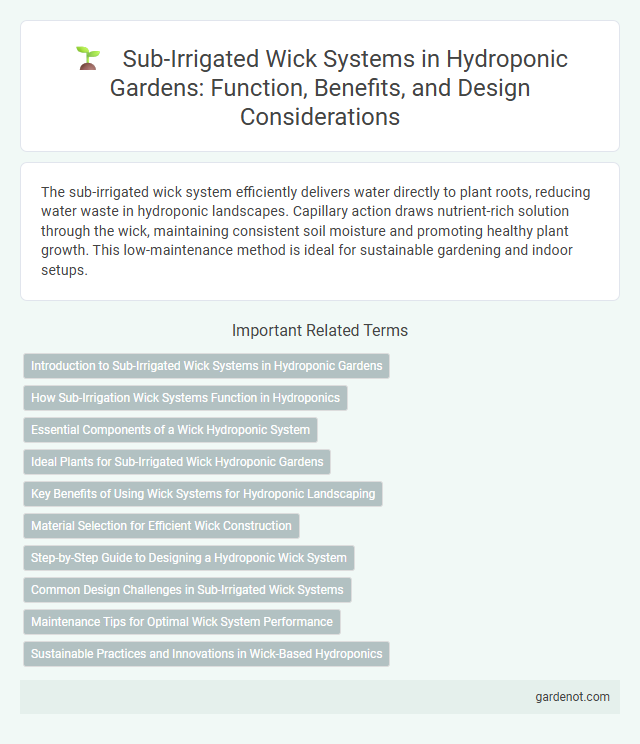The sub-irrigated wick system efficiently delivers water directly to plant roots, reducing water waste in hydroponic landscapes. Capillary action draws nutrient-rich solution through the wick, maintaining consistent soil moisture and promoting healthy plant growth. This low-maintenance method is ideal for sustainable gardening and indoor setups.
Introduction to Sub-Irrigated Wick Systems in Hydroponic Gardens
Sub-irrigated wick systems in hydroponic gardens utilize a passive irrigation method where nutrient solution is drawn up through a wick from a reservoir to the plant roots, ensuring consistent moisture levels for optimal growth. This system minimizes water waste and reduces the risk of overwatering by maintaining a stable water supply without the need for pumps or complex equipment. Ideal for small-scale or beginner hydroponic setups, sub-irrigated wick systems promote efficient nutrient uptake and healthy root development in various crops.
How Sub-Irrigation Wick Systems Function in Hydroponics
Sub-irrigated wick systems function in hydroponics by using capillary action to draw nutrient-rich water from a reservoir directly to plant roots through a wick material. This passive system maintains consistent moisture levels, reducing water waste and promoting efficient nutrient uptake. Ideal for small-scale or low-maintenance hydroponic setups, the wick system supports healthy plant growth without the need for pumps or complex equipment.
Essential Components of a Wick Hydroponic System
Essential components of a sub-irrigated wick hydroponic system include a water reservoir, a growing container filled with a soilless medium, and a wick made from absorbent material such as cotton or nylon. The wick transfers nutrient-rich water from the reservoir to the plant roots, ensuring consistent moisture without overwatering. Maintaining proper wick thickness and medium porosity is crucial for optimal capillary action and healthy plant growth.
Ideal Plants for Sub-Irrigated Wick Hydroponic Gardens
Herbs like basil, mint, and chives thrive in sub-irrigated wick hydroponic gardens due to their moderate water needs and shallow root systems. Leafy greens such as lettuce, spinach, and arugula perform exceptionally well because the wick system maintains consistent moisture levels without waterlogging roots. Small fruiting plants like strawberries also adapt to this method, benefiting from steady hydration and nutrient delivery throughout their growth cycle.
Key Benefits of Using Wick Systems for Hydroponic Landscaping
Sub-irrigated wick systems in hydroponic landscaping offer efficient water usage by delivering nutrients directly to plant roots through capillary action, reducing water waste and promoting consistent moisture levels. This passive system minimizes the need for pumps or electricity, lowering maintenance costs and making it ideal for small-scale or indoor setups. Enhanced oxygen availability and reduced risk of root rot improve plant health and growth rates, resulting in vibrant, sustainable landscapes.
Material Selection for Efficient Wick Construction
Selecting high-quality, porous materials like cotton or nylon wicks ensures efficient water absorption and distribution in sub-irrigated wick hydroponic systems. Natural fibers offer better capillary action, promoting consistent moisture delivery to plant roots while synthetic options provide durability and mold resistance. Optimal wick thickness and length tailored to specific plant water requirements enhance nutrient uptake and overall system performance.
Step-by-Step Guide to Designing a Hydroponic Wick System
Designing a hydroponic wick system begins by selecting a suitable container with proper drainage and waterproof lining to prevent leaks. Next, choose an absorbent wick material such as cotton or nylon that can efficiently draw nutrient solution from the reservoir to the growing medium. Finally, position the wick to maintain consistent moisture to plant roots, ensuring optimal nutrient uptake and healthy hydroponic plant growth.
Common Design Challenges in Sub-Irrigated Wick Systems
Sub-irrigated wick systems often face challenges such as uneven water distribution, which can lead to inconsistent plant growth and nutrient uptake. Wick length and material selection directly impact water capillary action, making optimization crucial to avoid dry spots or waterlogging. Maintaining a proper balance between the reservoir water level and wick saturation is essential to prevent root rot and ensure efficient hydroponic landscape performance.
Maintenance Tips for Optimal Wick System Performance
Regularly inspect and clean the wick to prevent clogging and ensure consistent water absorption in hydroponic wick systems. Monitor nutrient solution levels and refill promptly to avoid drying out the wicks, which can stress plants and reduce growth. Periodic testing of pH and electrical conductivity (EC) values helps maintain optimal nutrient availability and promotes healthy plant development.
Sustainable Practices and Innovations in Wick-Based Hydroponics
The sub-irrigated wick system exemplifies sustainable practices in hydroponic landscapes by minimizing water use through capillary action, ensuring efficient nutrient delivery without runoff. Innovations in wick-based hydroponics include biodegradable wick materials and automated moisture sensors, enhancing nutrient uptake while reducing environmental impact. This method supports resource conservation and promotes eco-friendly urban agriculture by utilizing renewable inputs and reducing wastewater.
Sub-irrigated wick system Infographic

 gardenot.com
gardenot.com